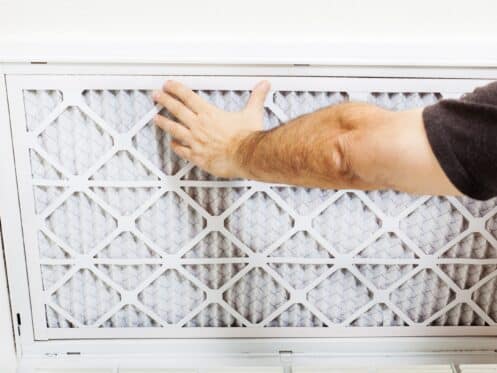When it comes to your home, you want to create a healthy environment for yourself and your loved ones. Indoor air quality is crucial to your overall well-being, impacting your respiratory health and comfort. Poor air quality can lead to breathing difficulties, allergies, and even more severe health issues. In addition, taking steps to improve indoor air quality also has a positive environmental impact.
The Importance of Improving Indoor Air Quality
Indoor air quality has become a top priority for many people in recent years and for a good reason. Most people spend a significant amount of time at home, and this time has only increased with the rise of remote work. The quality of the air that you breathe indoors directly impacts your health. Harmful pollutants like smoke and lead dust can contribute to more severe health concerns. Therefore, it’s essential to take a step to improve your indoor air this summer.
1. Change Your Air Filters
One simplest and most effective way to improve indoor air quality is to change your air filters regularly. If you rely on an air conditioner or HVAC system in your home, the air filters are crucial in providing clean air. Over time, these filters can become clogged with debris, reducing efficiency and negatively impacting indoor air quality. To avoid this, schedule HVAC maintenance to take care of your systems and your furnace and air conditioner filters. Changing them every three months is recommended to keep your air cleaner as it circulates throughout your home.
2. Decorate With Indoor Plants
Indoor plants add beauty to your home decor and improve indoor air quality. Plants can absorb carbon dioxide and release oxygen, making the air cleaner. While the effectiveness of plants in purifying indoor air is still a topic of debate among researchers, there is evidence to suggest that certain plants can help reduce indoor air pollution.
Choose large, leafy varieties with a high surface area. These plants are believed to have a greater influence on air purification. Some popular indoor plants known for their potential air-purifying properties include Boston fern, golden pothos, palm tree, English ivy, bamboo palm, and aloe vera. Incorporating these plants into your home improves air quality and creates a calming, natural atmosphere.
3. Seal Your Home
Ensuring that your home is adequately sealed can help prevent outdoor pollutants from entering and compromising indoor air quality. Windows and doors are common areas where air leaks can occur, leading to a decrease in the efficiency of your heating and cooling systems.
In addition to sealing windows and doors, addressing cracks in your walls or foundation is essential. These small openings allow outdoor pollutants, such as vehicle exhaust, factory emissions, and pollen, to enter your home. Sealing these cracks can help maintain clean indoor air and prevent the infiltration of harmful substances.
Insulating your walls, garage, and attic is another effective way to improve indoor air quality. Proper insulation reduces heat flow and keeps your home at a consistent temperature, reducing the workload on your HVAC system which reduces the need for future HVAC repairs and lowers energy consumption substantially.
4. Check Your Radon Levels
Radon is a colorless and odorless gas that can pose a serious health risk if it accumulates indoors. It is a byproduct of natural decay in the soil and can seep into homes through cracks and air leaks. Prolonged exposure to high radon levels has been linked to an increased risk of lung cancer.
It is essential to test for radon levels. If they’re high, seeking professional assistance to mitigate the issue is a good idea. This may involve installing an underground ventilation system or increasing air change rates to reduce radon concentration.
5. Maintain a Regular Cleaning Routine
Regular cleaning is not only crucial for maintaining a tidy home but also for improving indoor air quality. Dust, allergens, and other particles can accumulate on floors, furniture, and other surfaces, leading to poor air quality. By implementing a regular cleaning routine, you can reduce the presence of these pollutants and create a healthier living environment.
Vacuuming your floors, washing your sheets regularly, and dusting off furniture surfaces are essential to maintaining clean indoor air. These actions help remove dust mites, pet dander, and other allergens that impact air quality.
6. Use Natural Cleaning Products
Many household cleaning products contain chemicals that can harm your health and the environment. Harsh chemicals like ammonia and chlorine can irritate the skin and lungs, and their residues can linger on surfaces and in the air. Switching to natural cleaning products is a great way to improve indoor air quality and reduce exposure to harmful substances.
There are numerous natural alternatives available for cleaning purposes. Ingredients such as baking soda, vinegar, white vinegar, liquid castile soap, natural salt, and borax can be used effectively to clean various surfaces in your home. These natural cleaning agents are safer for your health and are eco-friendly.
7. Be Mindful of Home Renovations
Home renovations can breathe new life into your living space and increase your home’s value. However, they can also introduce harmful chemicals into the air. Many paints, sealants, adhesives, and building materials contain volatile organic compounds (VOCs) that can contribute to indoor air pollution.
When planning a renovation project, choosing low-VOC or VOC-free products is vital to minimize the release of these harmful substances. These products are designed to emit fewer pollutants and provide a safer environment for you and your family. Researching and selecting paints, furnishings, and building materials prioritizing low VOC emissions can significantly improve indoor air quality.
8. Remove Shoes Before Entering Your Home
Shoes can track in dirt, dust, and other pollutants from the outside, compromising indoor air quality. Creating a shoe-free environment in your home can significantly reduce indoor pollution. Designate an area near the entrance of your home for shoe storage, such as a shoe rack or mat. Encourage family members and guests to remove their shoes upon entering, especially on rainy or snowy days when shoes are likely to be heavily soiled.
9. Seek Professional Help
If you are concerned about the indoor air quality in your home, it’s always a good idea to seek professional help. Our team at Aace's Heating, Air Conditioning & Swamp Coolers specializes in HVAC services in Victorville and the Inland Empire and can provide expert advice and solutions to improve indoor air quality. Whether inspecting and maintaining your HVAC system, installing air purifiers, or testing for radon, our professionals can help ensure that your home has clean and healthy air.
By implementing these simple yet effective tips, you can significantly improve the indoor air quality of your home. Breathing cleaner air contributes to better respiratory health, increased comfort, and improved overall well-being for you and your family. If you’re looking for air duct cleaning and solutions to improve indoor air quality in Victorville, look no further. Our team of experts is dedicated to providing comprehensive HVAC services to ensure your home’s air is pollutant-free. Contact Aace's Heating, Air Conditioning & Swamp Coolers today for more information and to schedule a consultation.
Services We Offer include:






